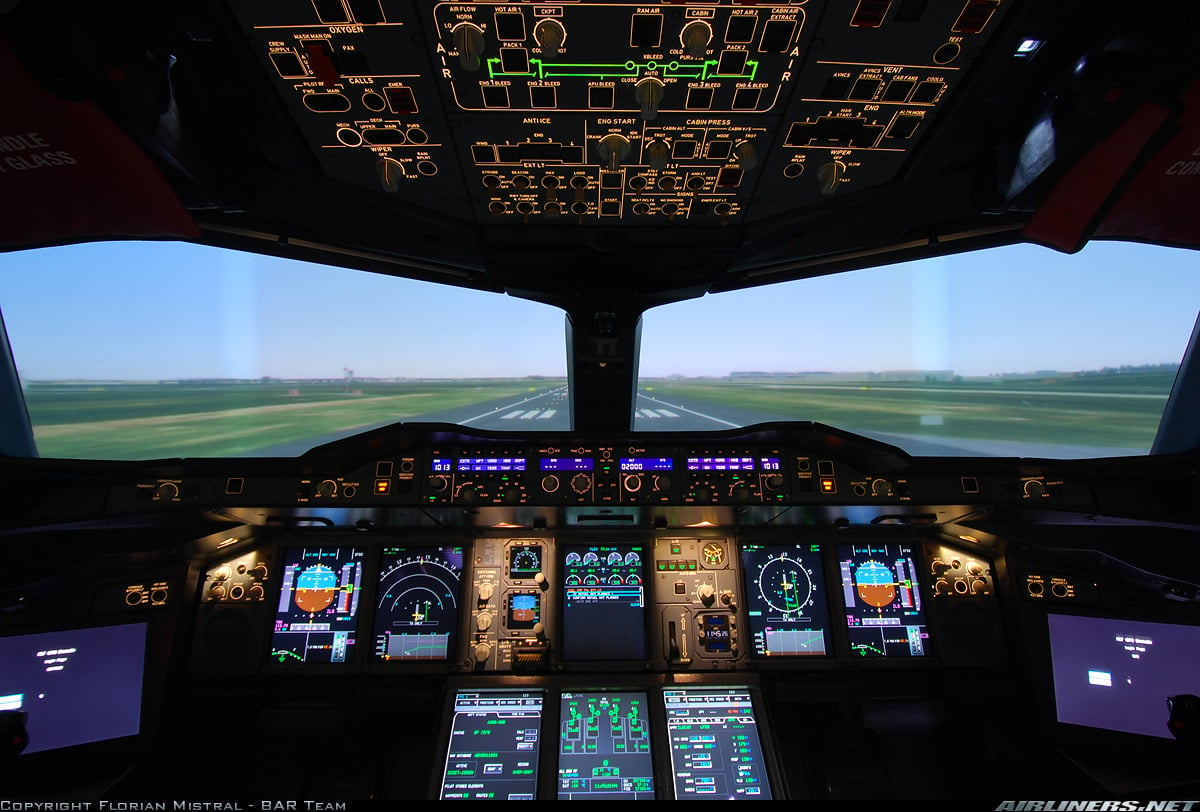

Handling, motion, systems replication and visuals are all state-of-the-art.” Lenz said: “The evolution that has taken place with the development of aircraft has been mirrored in simulation technology.
A380 cockpit full#
Lenz and Pruess were full of praise for the realism of the simulator, saying they could not tell the difference between the sim and the real aircraft. Finally, there is an additional session to complete the course and be signed off to Zero Flight Time Training (ZFTT) level. Further training is then conducted for Advanced Type Training (ATT), followed by three sessions for Line Oriented Flight Training (LOFT), which aims to recreate real-life airline operations. This is followed by sessions in the high-pressure environment of the simulator.Įach session lasts four hours and a typical pilot will be in the sim for four sessions to learn the skills required for his/her Basic Type Training (BTT). After the equivalent of five days of self-study, there are two to three days of classroom instruction, covering aircraft systems, performance and operations. The syllabus has been created in tandem with Airbus and the German aviation authorities.
A380 cockpit simulator#
The simulator is a Class D, ‘Zero Time’ machine, so-called because pilots are not required to fly any hours in the real aircraft to obtain a type-rating and be ready to fly with passengers aboard in normal line operations. However, at Lufthansa, so many pilots transition from other Airbus variants that these stages are unnecessary and the carrier operates just one Thales full-motion six-axis A380 simulator, located at the airline’s wholly-owned training subsidiary in Frankfurt. Furthermore, on more modern types, a large amount of time is spent learning to navigate the flight management system (FMS) computers and their complex network of menus and functions. Traditionally the first step in learning to fly a new type would be in a procedural trainer, which dispenses with motion and visuals as an unnecessary expense and enables students to focus on the location of switches and buttons and their function inside the cockpit, and to learn the procedures and flows. Photo: Hi Fly A380 with Captain Carlos MirpuriĪny pilot who has flown an Airbus before will find themselves at home in the A380 cockpit. Only a Differences course is required for a pilot to transition to a new variant, which in some cases can be just three days.


This means pilots of all Airbus airliners from the A318 to A380, which are considered different types with different type-ratings, can fly them using Crew Cross Qualification (CCQ). One of the signature achievements of Airbus is a common cockpit across the entire product range and using fly-by-wire technology to artificially iron out differences to give similar handling characteristics. Photo: Wikimedia Commons/Konstantin von Wedelstaedt Common Cockpit of Airbus Training for the rank of Senior First Officer includes additional duties. Even the most junior pilot is expected to be able to operate and land the aircraft solo in the event of crew incapacitation. Half of those first officers are ranked as Senior First Officers and are designated as the acting pilot-in-command (PIC) while the captain is in the bunk for crew rest. As most sectors are long haul, they are operated by a captain and two first officers, to allow rest periods during the flight therefore, the A380 pilot group is made up of around one-third captains and two-thirds first officers. The carrier’s A380 fleet comprises 14 aircraft (albeit at least half will not be reactivated after the Coronavirus shutdown), which requires a pool of appropriately 380 pilots. That transition usually involves graduating from short haul A320 fleet to the long haul fleet to fly either the Airbus A330/A340, the Boeing 747-400/-8i, or the Airbus A380. Given the high cost of training a pilot on new hardware, Lufthansa pilots change type only once as a co-pilot and once as a captain in their career. “Absolutely!” they replied simultaneously, at the beginning of an exclusive interview I did with them back in 2018.Īll Lufthansa pilots start on short-haul sectors, which since the retirement of the last of the airline’s Boeing 737s in 2016, means flying the Airbus A320 series. The Airbus A380 is the biggest airliner in the world and must surely represent the pinnacle of a pilot’s flying career? This was one of the questions I posed to Lufthansa’s two A380 chief training captains, Richard Lenz and Geert Pruess.


 0 kommentar(er)
0 kommentar(er)
